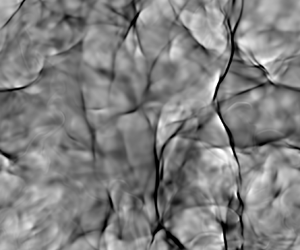Published online by Cambridge University Press: 21 October 2022

Enstrophy production and flow topology are numerically investigated for statistically stationary compressible isotropic turbulence in vibrational non-equilibrium with a large-scale thermal forcing. The net enstrophy production term is decomposed into solenoidal, dilatational and isotropic dilatational terms based on the Helmholtz decomposition. From the full flow field perspective, the net enstrophy production mainly stems from the solenoidal term. For the dilatational and isotropic dilatational terms, although their local magnitudes can be considerable, the positive values in the compression region and the negative values in the expansion region cancel out on average. For the solenoidal component of the deviatoric strain-rate tensor, the statistical properties of its eigenvalues and alignments between vorticity and its eigenvectors are nearly independent of the local dilatation and vibrational relaxation. The solenoidal components of enstrophy production along three eigendirections are thus mainly affected by the vorticity. For the dilatational component of deviatoric strain-rate tensor, the statistical properties of its eigenvalues and alignments between vorticity and its eigenvectors closely relate to the local dilatation and vibrational relaxation. The dilatational components of enstrophy production along three eigendirections are therefore affected by the vorticity, eigenvalues and alignments between the vorticity and eigenvectors. The topological classification proposed by Chong et al. (Phys. Fluids, vol. 2, issue 5, 1990, pp. 765–777) is employed to decompose the flow field into various flow topologies. In the strong compression and strong expansion regions, the relaxation effects on the volume fractions of flow topologies and their relative contributions to the local enstrophy production are significant.